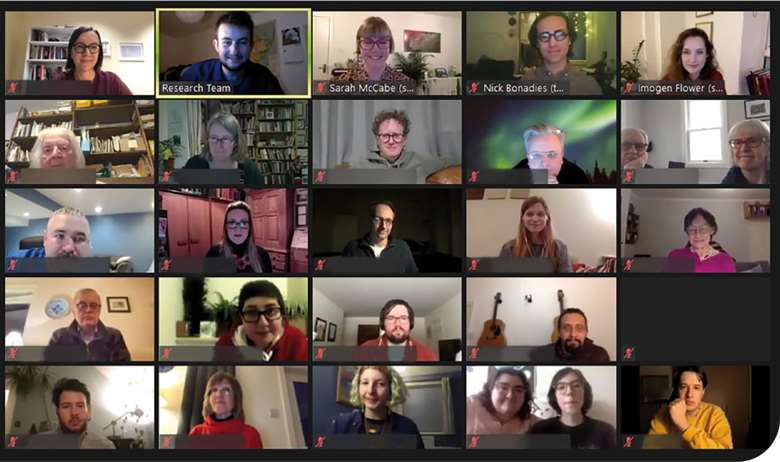Conference report: Queering the Conservatoire - Beyond the diversity checklist
Claire Jackson
Sunday, April 25, 2021
In February, Guildhall School of Music & Drama hosted 'Queering the Conservatoire – Beyond the diversity checklist' online as part of its Research Works series. Claire Jackson reports on the event.

‘Thank you for braving the snow to join us tonight,’ says Nick Bonadies as they launch Guildhall School of Music and Drama's Queer Performance Department. Gentle chuckling ensues – we're still in lockdown so of course this is a virtual event, held via Zoom as part of Guildhall's Research Works, the conservatoire's regular series created to share the latest findings with students, staff and the public.
Our commute to the Barbican is not the only thing we are imagining: the Queer Performance Department is unofficial. Three doctoral researchers – Bonadies is joined by Sarah McCabe and Imogen Flower – are examining approaches to queerness within music higher education, through a utopian depiction of what a queer (or at least queer-friendly) conservatoire might look like.
The two-part conference (8 and 15 February) explored some of the issues facing queer students and staff in conservatoires and music colleges. The researchers argued that even if the doors to higher education institutions are open, marginalised students must then navigate unwelcoming environments.
Bonadies, a pianist, provided an overview of their in-progress thesis that looks at how queer performance practice could be embraced as part of ‘mainstream’ classical interpretation. Bonadies shared some personal and upsetting accounts of their own musical education, where ‘wrong’ performances were invariably by non-conforming artists and assigned ‘deviant’ status. (One ‘wrong’ musician was pianist Glenn Gould, who Bonadies has delightfully reframed as their Aunt Glenn.) Flower and McCabe also introduced their work: a PhD about a musical theatre project made by and for sex workers and a study of the impact of open mics as run by and for marginalised artists.
The term ‘queer’ is purposely ambiguous; it is an umbrella term for everyone who identifies as being outside heteronormative society, particularly – but not limited to – the LGBT+ community. In recent years, much progress has been made to diversify education, yet there is still much to be improved.
Around 60 delegates attended the conference; most were Guildhall staff and students, others were studying at different conservatoires. Guildhall's director of music Jonathan Vaughan was also present – interpreted as a sign that the senior leadership team is taking this topic seriously.
Alongside their formal research, Bonadies, Flower and McCabe engaged with focus groups comprising queer students in conservatoires across the UK and Canada. Students were asked to reflect on how their queer identities might intersect with their artistry, how conservatoires may – or may not – have supported these intersections, and how utopian imaginations of the queer conservatoire might be realised. Most of the participants were studying classical music. More than one respondent spoke of a sense that queerness was an ‘additive’ that could be removed at will, with the recommendation from tutors that ‘identities should be left at the door’. Conversely, there was also an expectation that, in the case of trans students, work would always be related to their trans identity.
Multiple respondents discussed canonicity and the fact that there was always a need to justify – and often fight for – repertoire outside of the three Bs (Beethoven, Bach and Brahms). This is particularly true of contemporary music, which is still often treated as lesser or other. One student believed that better integration of ideas was needed, in order to, in their words, avoid giving the impression that ‘feminist’, ‘black’ and ‘queer’ perspectives were taught as extras alongside the ‘norm’.
During the concluding discussions – and the informal Q&A in the ‘pub’ afterwards – presenters and delegates appeared to agree that the desires the students had expressed are those that many people wish to see in the music world more broadly. There was a consensus that conservatoires and higher education institutions often tend to be in the business of ‘teaching craft’ rather than artistry; churning out technically proficient musicians instead of rounded artists.
Both students, researchers and staff seemed keen for a deeper, more thoughtful approach to learning – and an environment where ground-breaking, high-quality, individualistic and distinctive music-making can thrive.
How can higher education support queer students?
The work undertaken by Bonadies, Flower and McCabe contains a ready-made list of recommendations to diversify conservatoire spaces. Most of these are relatively easy and inexpensive – for further information, please contact research@gsmd.ac.uk.
- Consider the curriculum Ensure that students are exposed to a broad range of musicians and composers.
- Normalise use of pronouns Visiting tutors and staff should be encouraged to add their pronouns to their introductions (this was modelled in the Queer Conservatoire conference and worked well).
- Provide more options on forms If you must include tick boxes, make sure that no-one feels left out.
- Gender-neutral toilets Where possible, ensure there are dedicated facilities for non-binary people – choose signage carefully, ideally in conversation with student bodies.
- Proactive not reactive Engage with challenging discussions and make it easier for students and staff to respond to feedback in a constructive way.

